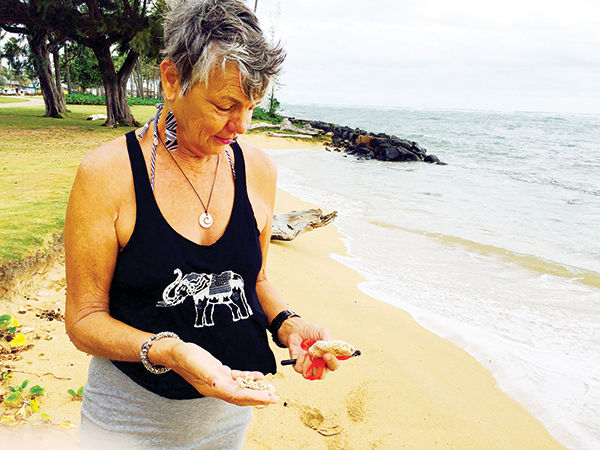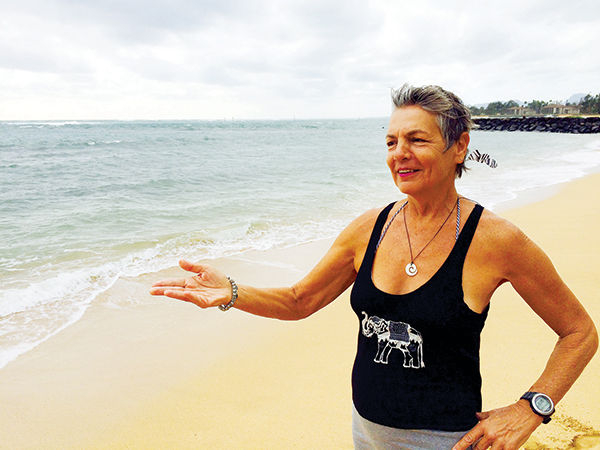Most days, Katherine Muzik can be found along the stretch of coastline between the Kapaa swimming pool and public library, on Kauai’s Eastside.
In many ways, she has adopted this area. And it is here, along a section of dredged-out reef, that she hopes a dream will become reality.
Originally from Michigan and raised in Puerto Rico, Muzik is a marine biologist, author and ocean lover. Last week, The Garden Island chatted with Muzik about her love of the sea, the years she spent in Japan and her plans for a coral garden in Kapaa.
The Garden Island: First, tell our readers a little about your background. Where are you from?
Katherine Muzik: I was born in Michigan, but luckily lived in Puerto Rico until age 8. Such a tropical paradise it was then, but suddenly though, uh oh, our family moved to Washington state, uh oh, Pullman, uh oh, no ocean, just wheat fields. So, next, I escaped that landlocked home to go to Pomona College in California, thinking I could visit Disneyland, which I did, and the sea, which I did, but it was too cold!
I escaped that then-so-smoggy college to go to Spain, to teach English, then came back to the University of Washington to study — in-state tuition, not my hometown, though, OK. Everybody can understand that?
Still worshipping the glittering sea, after U Dub I studied marine biology, first at Duke University — master’s degree, studying Fiji sea fans — then Miami, Florida, Ph.D, studying Hawaiian sea fans, via the Smithsonian and Harvard. Then I received an offer from Suntory Whiskey Company, whose president, Saji San, had just started an amazing biopharmaceutical branch, and I was asked to come to Japan to help them find ways to combat cancer, reduce high blood pressure, etc., from extracts of marine organisms. It was a total surprise to me, to go to Japan. I am too tall, I thought. But I came to love Japan, and especially Okinawa.
TGI: What first drew you to the ocean, and when/how did you know you wanted to be a marine biologist?
KM: Oh, what an interesting question that is to me, as I am trying to draw my experience with water, trying to draw, to bring attention to everyone. I am painting with watercolors, singing and dancing with words, trying to draw attention to our imperiled seas. Our seas, our Ahupu’aa, our streams, our waterfalls, everything, is connected by water, lack of water, poison in the waters. Our waters.
First, I was lucky to be the daughter of a really great guy, my dad, a tropical botanist, whose first job after graduating from the University of Michigan, where he was studying, thus, where I was born, was in Puerto Rico. I lived there with my family from age 1 until I was 8. So my first and happiest memories are of sunny, blue skies, salty blue seas, red hibiscus, green coconut palm trees, wonderful, sandy weekend picnics at the beach. Kind of like Kauai.
That is why I am here, 66 years later!
TGI: Do you have a favorite ocean critter? What makes it so special?
KM: Certainly, aside from my academic specialty, the octocoral sea fans, purple, red, orange, glistening white, which are incredibly beautiful, and live in all the shallow and deep seas, I love the manta ray! Once when I was swimming in Okinawa, between Kuro Island and Ishigaki, a manta came very near me, he swept over me, delicately, precisely, knowing exactly where I was, he waved his giant wings, perfectly, did not touch me, just hovered. I was fascinated. Then, 30 years later, when I happened to return to Ishigaki, to film mantas, with my film crew at Japan Underwater Films, I think the very same manta came by, he hovered, he visited me, he really, really looked at me, like “aloha.” They live 50 years or more, you know? They are extremely intelligent, look you in the eye, they know everything.
TGI: You spent many years living and working in Japan. Why did you decide to leave?
KM: I had no idea when I first arrived in Japan, that Okinawa was a separate country! It has a long history, over 18,000 years! A magnificent history! Its own language, food, drink, dance, everything. The Ryukyu Archipelago is known to themselves as home, it is Uchinan, not Okinawa (which translates to “offshore string” in Mainland Japanese! No way! They were, and hope to be, eventually, once again, their own sovereignty). I lived there, among fishermen and farmers, from 1981 to 1988 and then again, 2007 to 2011.
TGI: In February, you wrote a letter to Caroline Kennedy, U.S. Ambassador to Japan. What about?
KM: I was and I still am deeply disturbed by the recent plan, concocted by the Japanese and the American governments, to destroy the last coral reef in Okinawa. In fact, Japan. In fact, the last coral reef ecosystem in the Pacific. Mountains, forests, rivers, birds, tidal flats, corals, from top to bottom, precious …
“They” are planning to bring 3.5 million truckloads of fill, to suffocate the most beautiful reef I have ever seen — at Oura Bay, in northeast Okinawa. It is a beautiful place, with 1,000 species of fish, 400 species of coral, and it is home to the rare and endangered dugongs, plus 700 seagrasses and algae, plus all the species of clownfishes known in Japan.
They are so cute, so helpless against human invasion. Bye, Nemo? Quite unbelievable, that it could be so thoughtlessly destroyed, isn’t it?
I was invited to dive there by local sympathetic Okinawan comrades last September, and I had a fantastic visit. … So I wrote to Caroline Kennedy, and invited her to dive with me, to experience the beauty of life in the sea, to help protect it.
I even sent her my books, along with my letter, but, no answer whatsoever.
I asked Congresswoman Tulsi Gabbard to help me reach her. In person, Tulsi promised me she would talk with Caroline. Nothing. I am disappointed but not daunted.
TGI: How would you describe the state of our reefs and ocean here on Kauai? How do they compare to Japan?
KM: Our reefs, and all the reefs of the world are in deep distress. I think Anini here in Kauai is perishing, perhaps beyond recovery? Ever?
Too many golf courses using glyphosates and 2,4-D to make their perfect grass, too many cesspools, too many automobile tires grinding down their horrible chemicals which assail the roads to wash into the sea, too much sunscreen which kills corals. It is totally awful. Very discouraging.
So, I am starting a reef restoration project here in Kapaa. I have named it Mala Moana, meaning ocean garden. I am so happy to find so much support for this effort! We are right behind the library in Kapaa. I will pay kids from local schools to help me!
I already have events scheduled for fundraising in January. For example, at Restore Kauai, we will have hula dancers —Tamatea Nui o Kauai — and bands. … Also fund-raising events at Feral Pig and Malama Auctions. We will celebrate life and hope, we have to do this.
TGI: Is it true you are the author of several children’s books? What are they about?
KM: Yes, I have published only five books so far, all about the ocean. My first, “Ellisella the Coral,” is the best one because it is bilingual, English and Japanese. It was first published a long time ago, with the message that we must all care about everything, all the time.
It was republished this year, quite a surprise to me, a happy one. Same message. My other books are in English, Spanish, Chinese, same theme, life in our beautiful seas.
My new book is about water, “Waterdrop Waterdrop,” in English, Hawaiian, Japanese, Spanish, soon in Chinese and Arabic! Wow. Kulu wai kulu wai. We share the Earth, which is a water drop, which is what I am writing about!
You are a water drop, I am too, why don’t we humans behave, act like water, when we meet, coalesce to make sea, rivers, rainbows.
TGI: What is the most amazing thing you have seen below the surface?
KM: Oh, without a doubt a magnificent bioluminescent coral, which I discovered and named, Lepidisis olapa, so wonderful! I was in a submarine off Makapu’u, Oahu, at 1,400 feet. So deep, so dark, I finally was able to convince Boh, the submarine operator, the sub’s engineer, to turn off the lights, and lo, wow, this beautiful coral just glittered, flashed centimeter-long flashes of light, up and down, and back and over again, so wonderful! Boh was impressed too. I named it! Olapa! Lepidisis olapa Muzik. One of my children.
TGI: What do you see as the biggest threat to Kauai’s marine environment? Is it too late to reverse the trend? Where should we focus out efforts today?
KM: Right now we have global warming, too terrible, a “blob” of warm water is not only bleaching our corals here in Kauai but bleaching the kelp off Catalina Island in California, also irreparably harming the shrimp fisheries off Massachusetts.
The fish guys there are pulling up only inedible, tough green crabs, which eat whatever was in their traps. It is so too warm! So that is one problem. Too warm, the seas and skies, yes, caused by us! By all of our greedy human activities.
Then I am deeply worried about garbage. I volunteered for a few events to promote Zero Waste, at the County Fair in Lihue, even at Hanalei for canoeing, but nobody seems to care. How can that be, they just throw stuff away. But it does not ever go away.
So, garbage, especially pollution from cesspools, we have to change that! Right now. Water runs downhill, carrying everything toxic to the sea. The birth control pills, the Prozac, all the stuff we humans flush away, ends up in the sea. The corals are stuck there, dying.



